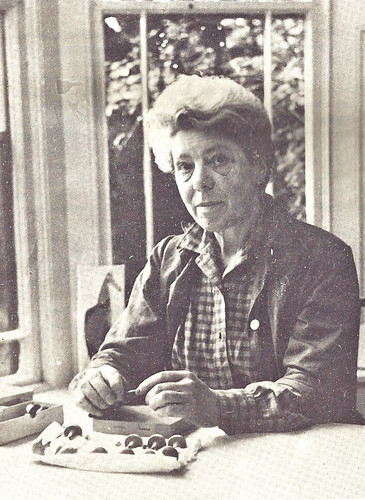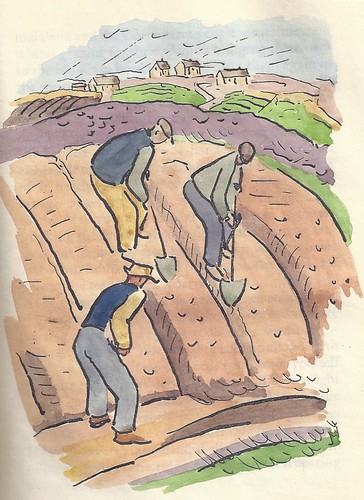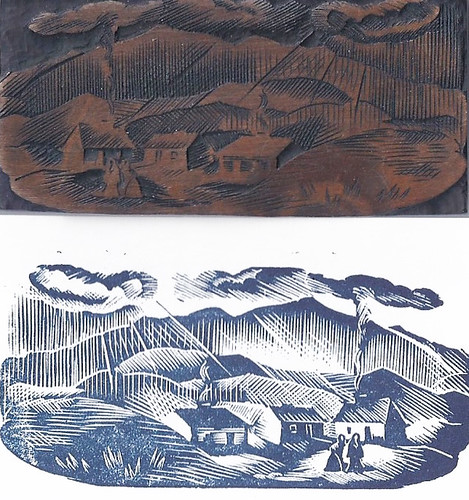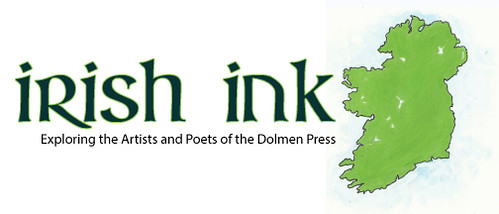This article is more than 5 years old.
This installment of Irish Ink is introducing Dolmen Press artist, Elizabeth Rivers. Rivers contributed a number of illustrations to the Dolmen Press oeuvre, which ZSR Library Special Collections and Archives is proud to house.
Elizabeth Joyce Rivers was born in Little Pennys, Sawbridgeworth, Hertfordshire on August 5, 1903. She was English, not Irish, which was not clear to many Irish who considered her one of their own. Rivers was one of five children and came from an affluent background. Her mother died when she was young and she was sent to a boarding school.

After finishing school, she studied at Goldsmith College under Edmund J. Sullivan (1869-1933) and the Royal Academy Schools (London) where she focused on painting. Rivers was influenced by English printmaker, Noel Rooke (1881-1953) and his use of “white line” printmaking influenced her work and style. After studying at Goldsmith College, Rivers also studied with French artist, Andrew Lhote and Italian Futurist, Gino Severini at Ecole de Fresque in Paris. While in Paris, Rivers met many Irish women painters, including Norah McGuinness, whom she worked with at the Graphic Studio Dublin and who also contributed to the Dolmen Press
Elizabeth Rivers worked as a freelance illustrator creating wood engravings for books and periodicals. She thought of herself as a painter and enjoyed that art form, although she is best remembered as a printmaker. She had her first solo show in 1933 at Wertheim Gallery in Manchester. In 1935, Rivers went to the Aran Islands off the coast of Ireland to paint and stayed for a year. She enjoyed the islands and began work on her memoir, Stranger in Aran, which was published by the Cuala Press in 1946. Rivers continued to live in this region for the next seven years.

In 1943, Rivers returned to London during the “Blitz” and worked putting out fires as a Fire Warden. Saying at the time: “The work was hell. I felt that what is happening in the world is one’s business. I have no belief that artists are separate people who should sit aside and nourish their own souls. “ During the war, Rivers worked on wood engravings which appeared in her book, Out of Bedlam, published in 1956 by The Dolmen Press.

After the war, Rivers returned to Ireland, where she met Evie Hone, with whom she worked until Hone’s death in 1955. Together, they created stained glass pieces. The best known of these is an 18 pane window at Eton College Chapel done in 1946-52. Rivers took Hone’s small drawings and enlarged them into cartoons for cutting the stained glass.
Rivers continued to work on her own paintings and drawings during the 1950’s and had several shows of her work. In 1960, Rivers was one of the founders of The Graphic Studio Dublin (GSD), a fine-art print studio, in Dublin. Dolmen Press artists Liam Miller and Leslie MacWeeney were also co-founders with Elizabeth Rivers.

In an interview with The Irish Times in 1962, Rivers stated: “ My work is a whole way of life. And my life is the food, the material out of which I make paintings and drawings and all the rest of it. I think all one’s experience goes into a crucible and comes out. You have two selves, the one that experiences, but there is also someone in the wings watching.”
Elizabeth Rivers died of a stroke at her home in Dublin on July 20, 1964.
Works Consulted
- Kennedy, Brian. (1989). Elizabeth Rivers 1903-1964- A Retrospective View. Dublin: Gorry Gallery.
- Lalor, Brian. (2011) Ink Stained Hands. Dublin: The Lilliput Press.
- Rivers, E., Miller, L., & Dublin (Ireland). Municipal Gallery of Modern Art. (1966). Elizabeth Rivers: Memorial exhibition. Dublin: Municipal Gallery of Modern Art.
- Rivers, Elizabeth. (1946). Stranger in Aran. Dublin: The Cuala Press.

